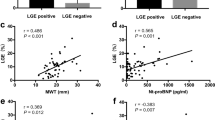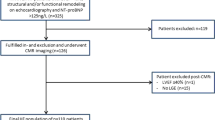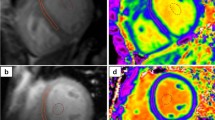Abstract
We aimed to determine the diagnostic performance of biomarkers in predicting myocardial fibrosis assessed by late gadolinium enhancement (LGE) cardiovascular magnetic resonance imaging (CMR) in patients with hypertrophic cardiomyopathy (HCM). LGE CMR was performed in 40 consecutive patients with HCM. Left and right ventricular parameters, as well as the extent of LGE were determined and correlated to the plasma levels of midregional pro-atrial natriuretic peptide (MR-proANP), midregional pro-adrenomedullin (MR-proADM), carboxy-terminal pro-endothelin-1 (CT-proET-1), carboxy-terminal pro-vasopressin (CT-proAVP), matrix metalloproteinase-9 (MMP-9), tissue inhibitor of metalloproteinase-1 (TIMP-1) and interleukin-8 (IL-8). Myocardial fibrosis was assumed positive, if CMR indicated LGE. LGE was present in 26 of 40 patients with HCM (65%) with variable extent (mean: 14%, range: 1.3–42%). The extent of LGE was positively associated with MR-proANP (r = 0.4; P = 0.01). No correlations were found between LGE and MR-proADM (r = 0.1; P = 0.5), CT-proET-1 (r = 0.07; P = 0.66), CT-proAVP (r = 0.16; P = 0.3), MMP-9 (r = 0.01; P = 0.9), TIMP-1 (r = 0.02; P = 0.85), and IL-8 (r = 0.02; P = 0.89). After adjustment for confounding factors, MR-proANP was the only independent predictor associated with the presence of LGE (P = 0.007) in multivariate analysis. The area under the ROC curve (AUC) indicated good predictive performance (AUC = 0.882) of MR-proANP with respect to LGE. The odds ratio was 1.268 (95% confidence interval 1.066–1.508). The sensitivity of MR-proANP at a cut-off value of 207 pmol/L was 69%, the specificity 94%, the positive predictive value 90% and the negative predictive value 80%. The results imply that MR-proANP serves as a novel marker of myocardial fibrosis assessed by LGE CMR in patients with HCM.



Similar content being viewed by others
Abbreviations
- AF:
-
Atrial fibrillation
- CMR:
-
Cardiovascular magnetic resonance imaging
- EF:
-
Ejection fraction
- HCM:
-
Hypertrophic cardiomyopathy
- LA:
-
Left atrium
- LGE:
-
Late gadolinium enhancement
- LV:
-
Left ventricular
References
Marian AJ, Roberts R (1995) Recent advances in the molecular genetics of hypertrophic cardiomyopathy. Circulation 92(5):1336–1347
Niimura H, Bachinski LL, Sangwatanaroj S et al (1998) Mutations in the gene for cardiac myosin-binding protein C and late-onset familial hypertrophic cardiomyopathy. N Engl J Med 338(18):1248–1257
Schwartz K, Carrier L, Guicheney P et al (1995) Molecular basis of familial cardiomyopathies. Circulation 91(2):532–540
Maron BJ, Spirito P (1998) Implications of left ventricular remodeling in hypertrophic cardiomyopathy. Am J Cardiol 81(11):1339–1344
Maron BJ (2002) Hypertrophic cardiomyopathy: a systematic review. JAMA 287(10):1308–1320
Varnava AM, Elliott PM, Sharma S et al (2000) Hypertrophic cardiomyopathy: the interrelation of disarray, fibrosis, and small vessel disease. Heart 84(5):476–482
Bottini PB, Carr AA, Prisant LM et al (1995) Magnetic resonance imaging compared to echocardiography to assess left ventricular mass in the hypertensive patient. Am J Hypertens 8(3):221–228
Lorenz CH, Walker ES, Morgan VL et al (1999) Normal human right and left ventricular mass, systolic function, and gender differences by cine magnetic resonance imaging. J Cardiovasc Magn Reson 1(1):7–21
Choudhury L, Mahrholdt H, Wagner A et al (2002) Myocardial scarring in asymptomatic or mildly symptomatic patients with hypertrophic cardiomyopathy. J Am Coll Cardiol 40(12):2156–2164
Kim RJ, Judd RM (2003) Gadolinium-enhanced magnetic resonance imaging in hypertrophic cardiomyopathy: in vivo imaging of the pathologic substrate for premature cardiac death? J Am Coll Cardiol 41(9):1568–1572
Moon JC, Reed E, Sheppard MN et al (2004) The histologic basis of late gadolinium enhancement cardiovascular magnetic resonance in hypertrophic cardiomyopathy. J Am Coll Cardiol 43(12):2260–2264
Germans T, van Rossum AC (2008) The use of cardiac magnetic resonance imaging to determine the aetiology of left ventricular disease and cardiomyopathy. Heart 94(4):510–518
Papavassiliu T, Schnabel P, Schroder M et al (2005) CMR scarring in a patient with hypertrophic cardiomyopathy correlates well with histological findings of fibrosis. Eur Heart J 26(22):2395
Kwon DH, Setser RM, Popovic ZB et al (2008) Association of myocardial fibrosis, electrocardiography and ventricular tachyarrhythmia in hypertrophic cardiomyopathy: a delayed contrast enhanced MRI study. Int J Cardiovasc Imaging 24(6):617–625
Lombardi R, Betocchi S, Losi MA et al (2003) Myocardial collagen turnover in hypertrophic cardiomyopathy. Circulation 108(12):1455–1460
Derchi G, Bellone P, Chiarella F et al (1992) Plasma levels of atrial natriuretic peptide in hypertrophic cardiomyopathy. Am J Cardiol 70(18):1502–1504
Fahy GJ, McCreery CJ, O’Sullivan F et al (1996) Plasma atrial natriuretic peptide is elevated in patients with hypertrophic cardiomyopathy. Int J Cardiol 55(2):149–155
Ogino K, Ogura K, Kinugawa T et al (2004) Neurohumoral profiles in patients with hypertrophic cardiomyopathy: differences to hypertensive left ventricular hypertrophy. Circ J 68(5):444–450
Hasegawa K, Fujiwara H, Koshiji M et al (1996) Endothelin-1 and its receptor in hypertrophic cardiomyopathy. Hypertension 27(2):259–264
Hamada M, Shigematsu Y, Kawakami H et al (1998) Increased plasma levels of adrenomedullin in patients with hypertrophic cardiomyopathy: its relation to endothelin-I, natriuretic peptides and noradrenaline. Clin Sci (Lond) 94(1):21–28
Seidler T, Pemberton C, Yandle T et al (1999) The amino terminal regions of proBNP and proANP oligomerise through leucine zipper-like coiled-coil motifs. Biochem Biophys Res Commun 255(2):495–501
Hinson JP, Kapas S, Smith DM (2000) Adrenomedullin, a multifunctional regulatory peptide. Endocr Rev 21(2):138–167
Robertson GL, Mahr EA, Athar S et al (1973) Development and clinical application of a new method for the radioimmunoassay of arginine vasopressin in human plasma. J Clin Invest 52(9):2340–2352
Struck J, Morgenthaler NG, Bergmann A (2005) Copeptin, a stable peptide derived from the vasopressin precursor, is elevated in serum of sepsis patients. Peptides 26(12):2500–2504
Morgenthaler NG, Struck J, Thomas B et al (2004) Immunoluminometric assay for the midregion of pro-atrial natriuretic peptide in human plasma. Clin Chem 50(1):234–236
Morgenthaler NG, Struck J, Alonso C et al (2005) Measurement of midregional proadrenomedullin in plasma with an immunoluminometric assay. Clin Chem 51(10):1823–1829
Morgenthaler NG, Struck J, Alonso C et al (2006) Assay for the measurement of copeptin, a stable peptide derived from the precursor of vasopressin. Clin Chem 52(1):112–119
Papassotiriou J, Morgenthaler NG, Struck J et al (2006) Immunoluminometric assay for measurement of the C-terminal endothelin-1 precursor fragment in human plasma. Clin Chem 52(6):1144–1151
Elmas E, Lang S, Erik Dempfle C et al (2007) High plasma levels of tissue inhibitor of metalloproteinase-1 (TIMP-1) and interleukin-8 (IL-8) characterize patients prone to ventricular fibrillation complicating myocardial infarction. Clin Chem Lab Med 45(10):1360–1365
Simonetti OP, Kim RJ, Fieno DS et al (2001) An improved MR imaging technique for the visualization of myocardial infarction. Radiology 218(1):215–223
Sievers B, Kirchberg S, Addo M et al (2004) Assessment of left atrial volumes in sinus rhythm and atrial fibrillation using the biplane area-length method and cardiovascular magnetic resonance imaging with TrueFISP. J Cardiovasc Magn Reson 6(4):855–863
Bland JM, Altman DG (1986) Statistical methods for assessing agreement between two methods of clinical measurement. Lancet 1(8476):307–310
Moon JC, Mogensen J, Elliott PM et al (2005) Myocardial late gadolinium enhancement cardiovascular magnetic resonance in hypertrophic cardiomyopathy caused by mutations in troponin I. Heart 91(8):1036–1040
Teraoka K, Hirano M, Ookubo H et al (2004) Delayed contrast enhancement of MRI in hypertrophic cardiomyopathy. Magn Reson Imaging 22(2):155–161
Rudolph A, Abdel-Aty H, Bohl S et al (2009) Noninvasive detection of fibrosis applying contrast-enhanced cardiac magnetic resonance in different forms of left ventricular hypertrophy relation to remodeling. J Am Coll Cardiol 53(3):284–291
Adabag AS, Maron BJ, Appelbaum E et al (2008) Occurrence and frequency of arrhythmias in hypertrophic cardiomyopathy in relation to delayed enhancement on cardiovascular magnetic resonance. J Am Coll Cardiol 51(14):1369–1374
Roldan V, Marin F, Gimeno JR et al (2008) Matrix metalloproteinases and tissue remodeling in hypertrophic cardiomyopathy. Am Heart J 156(1):85–91
Takemura G, Fujiwara H, Mukoyama M et al (1991) Expression and distribution of atrial natriuretic peptide in human hypertrophic ventricle of hypertensive hearts and hearts with hypertrophic cardiomyopathy. Circulation 83(1):181–190
McMurray J, Pfeffer MA (2002) New therapeutic options in congestive heart failure: part II. Circulation 105(18):2223–2228
Elmas E, Brueckmann M, Lang S et al (2008) Midregional pro-atrial natriuretic peptide is a useful indicator for the detection of impaired left ventricular function in patients with coronary artery disease. Int J Cardiol 128(2):244–249
von Haehling S, Jankowska EA, Morgenthaler NG et al (2007) Comparison of midregional pro-atrial natriuretic peptide with N-terminal pro-B-type natriuretic peptide in predicting survival in patients with chronic heart failure. J Am Coll Cardiol 50(20):1973–1980
Nishikimi T, Yoshihara F, Mori Y et al (2003) Cardioprotective effect of adrenomedullin in heart failure. Hypertens Res 26(Suppl):S121–S127
Elmas E, Lang S, Dempfle CE et al (2008) Diagnostic performance of mid-regional pro-adrenomedullin as an analyte for the exclusion of left ventricular dysfunction. Int J Cardiol 128(1):107–111
Suzuki T, Hoshi H, Mitsui Y (1990) Endothelin stimulates hypertrophy and contractility of neonatal rat cardiac myocytes in a serum-free medium. FEBS Lett 268(1):149–151
Neunteufl T, Berger R, Pacher R (2002) Endothelin receptor antagonists in cardiology clinical trials. Expert Opin Investig Drugs 11(3):431–443
Spieker LE, Noll G, Ruschitzka FT et al (2001) Endothelin receptor antagonists in congestive heart failure: a new therapeutic principle for the future? J Am Coll Cardiol 37(6):1493–1505
Sakai S, Miyauchi T, Kobayashi M et al (1996) Inhibition of myocardial endothelin pathway improves long-term survival in heart failure. Nature 384(6607):353–355
Behnes M, Papassotiriou J, Walter T et al (2008) Long-term prognostic value of mid-regional pro-adrenomedullin and C-terminal pro-endothelin-1 in patients with acute myocardial infarction. Clin Chem Lab Med 46(2):204–211
Serradeil-Le Gal C, Wagnon J, Valette G et al (2002) Nonpeptide vasopressin receptor antagonists: development of selective and orally active V1a, V2 and V1b receptor ligands. Prog Brain Res 139:197–210
Khan SQ, Dhillon OS, O’Brien RJ et al (2007) C-terminal provasopressin (copeptin) as a novel and prognostic marker in acute myocardial infarction: Leicester acute myocardial infarction peptide (LAMP) study. Circulation 115(16):2103–2110
Esposito A, De Cobelli F, Perseghin G et al (2009) Impaired left ventricular energy metabolism in patients with Hypertrophic Cardiomyopathy is related to the extension of fibrosis at gadolinium delayed enhanced MR imaging. Heart 95(3):228–233
Moon JC, McKenna WJ, McCrohon JA et al (2003) Toward clinical risk assessment in hypertrophic cardiomyopathy with gadolinium cardiovascular magnetic resonance. J Am Coll Cardiol 41(9):1561–1567
Conflict of interest
There is no potential conflict of interest to disclose for any of the co-authors.
Author information
Authors and Affiliations
Corresponding author
Additional information
Elif Elmas and Christina Doesch have contributed equally to this work.
Rights and permissions
About this article
Cite this article
Elmas, E., Doesch, C., Fluechter, S. et al. Midregional pro-atrial natriuretic peptide: a novel marker of myocardial fibrosis in patients with hypertrophic cardiomyopathy. Int J Cardiovasc Imaging 27, 547–556 (2011). https://doi.org/10.1007/s10554-010-9704-2
Received:
Accepted:
Published:
Issue Date:
DOI: https://doi.org/10.1007/s10554-010-9704-2




